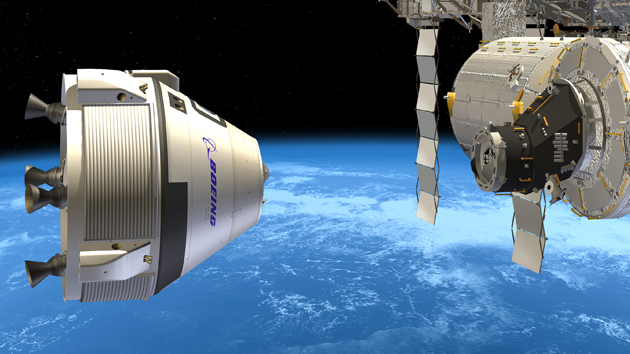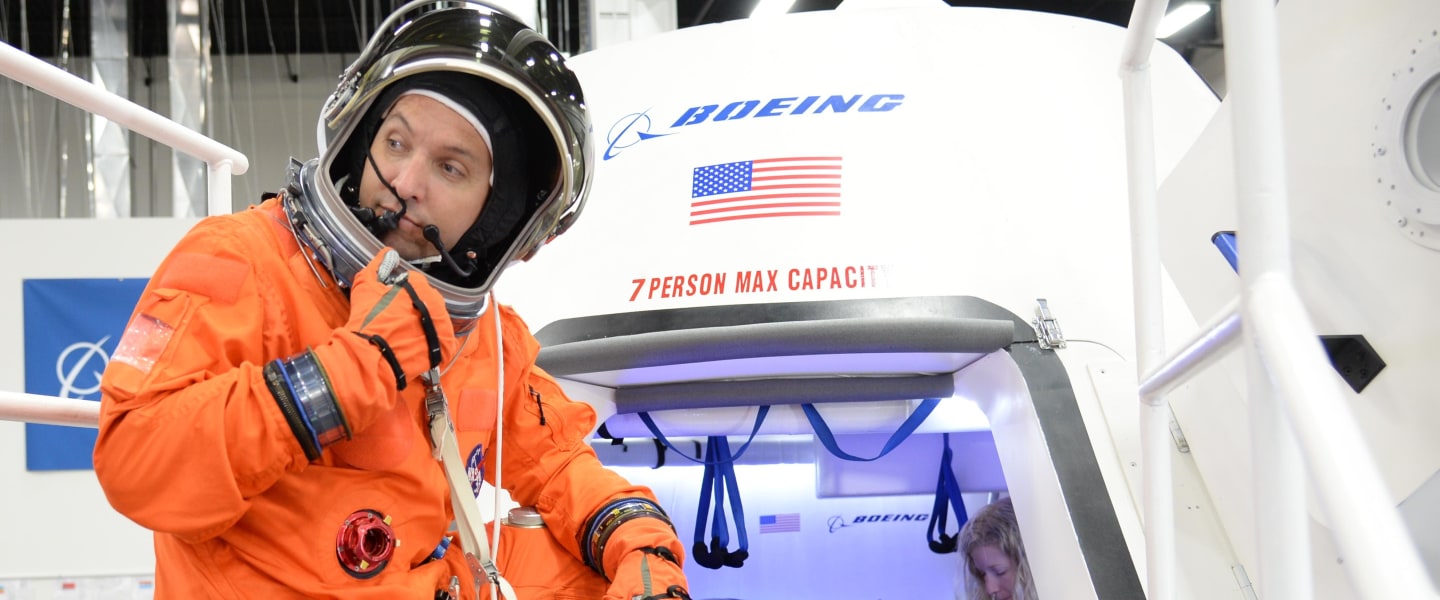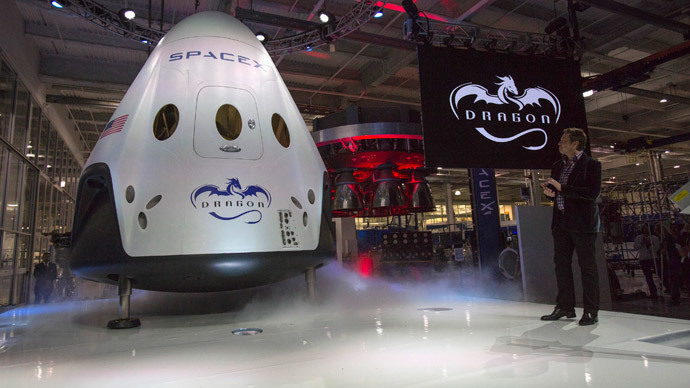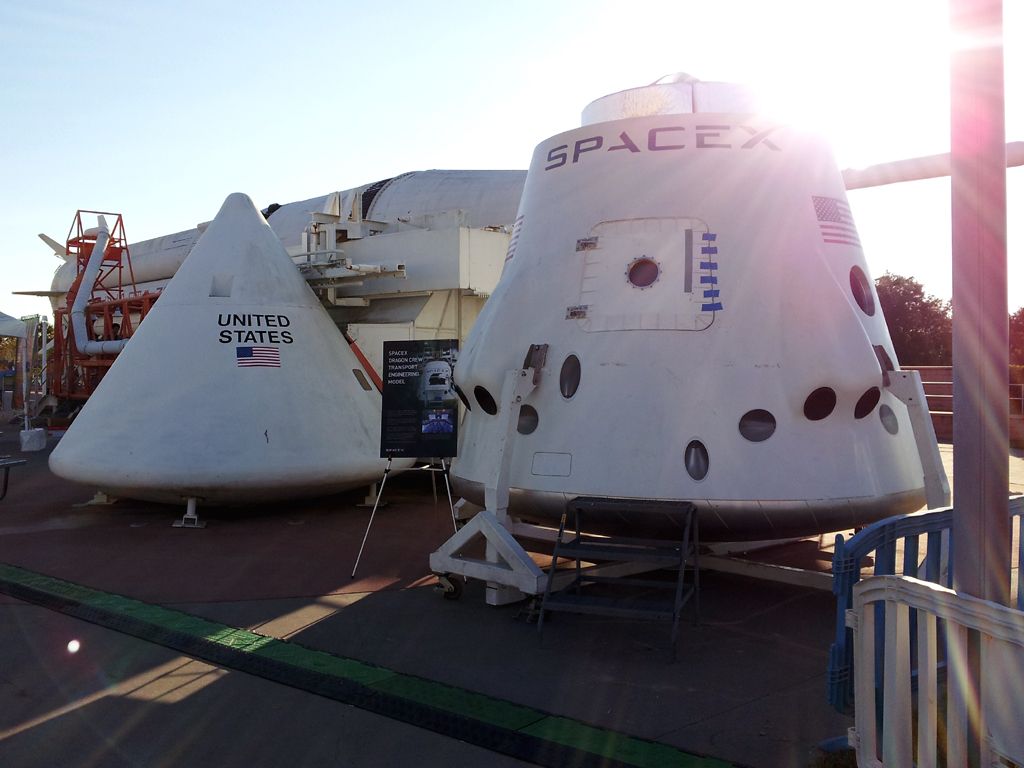NASA
2014

http://www.engadget.com/2014/09/16/boeing-and-spacex-win-nasa-contracts/
* Special thanks to "Google Images", NASA, "NBC News" , "RT"
BLOG POST
by Felicity Blaze Noodleman
Los Angeles, CA
9.19.14
NASA retired the legendary maned "Space Shuttles" program in 2011 after 20 years of service in space with no "Heir Apparent" or successor to continue NASA's space exploration ventures until this week. Aerospace manufactures have been designing and building prototypes hoping to win the bid to supply NASA with the next generation of space vehicles and now word has come from the space agency announcing the Boeing company has secured the contract to build "SpaceX's" (Space Exploration Technologies Corporation) proposed Dragon V2 capsule and thruster concept and design.
SpaceX is a new comer into the Aerospace manufacturing and design founded in 2002, and now taking the lead in maned space transportation with a fresh new, practical and cost effective program which seems to be a highly versatile and expandable series of space vehicles as the next generation picking up where the Shuttle program ended. 2017 is the target date for the new SpaceX Dragon V2 completion, delivery and operation into NASA's new shuttle program.
"NBC News"
Boeing and SpaceX Will Shuttle American Astronauts To ISS

NASA Gives $6.8 Billion to Boeing and SpaceX for Apollo-Style Spaceships
(NBC News / BOEING)
NASA
is going back to the future with $6.8 billion in backing for Apollo-style
spaceships designed by Boeing and SpaceX. Both companies have been given the
go-ahead to build, test and fly their gumdrop-shaped "space taxis,"
with the aim of transporting astronauts to and from the International Space
Station starting in 2017.
"Today,
we're one giant leap closer to launching our astronauts from the U.S. on
American spacecraft," NASA Administrator Charles Bolden said Tuesday from
Kennedy Space Center in Florida.
Since
the retirement of the space shuttle fleet in 2011, NASA has had to rely on the
Russians for rides to the station, at a cost topping $70 million per seat.
Tuesday's award is the latest phase in a years-long commercial effort aimed at
fixing that situation — an effort that already has cost NASA $1 billion.
"The
greatest nation on Earth should not be dependent on any other nation to get to
space," Bolden said.
Boeing
will get most of the funds for its CST-100 capsule, $4.2 billion, said Kathy
Lueders, the head of NASA's commercial crew program. But SpaceX wasn't left out
in the cold: Its crew-capable Dragon capsule won $2.6 billion from the
Commercial Crew Transportation Capability program, known as CCtCap for short.
SpaceX
has been launching uncrewed, cargo-carrying versions of the Dragon to the
station atop its Falcon 9 rocket since 2012, but the Dragon V2 craft is being
upgraded with all the safety features that NASA says will be needed for
carrying astronauts.
Boeing
has not yet built a flightworthy model of its CST-100 craft. The company's
executives said they were relying on CCtCap funding to proceed with
construction. But Boeing can draw upon decades of experience in spaceship
construction — including its experience as prime contractor for the
International Space Station. The CST-100 would be launched by Atlas 5 rockets
from United Launch Alliance, a joint venture between Boeing and Lockheed
Martin.
Both
the CST-100 and the Dragon are capable of carrying up to seven astronauts, and
both have a roughly conical look that's well-suited to the kind of atmospheric
re-entry and ocean splashdown that astronauts experienced at the end of each
Apollo moon mission. SpaceX is working on technologies that would allow for
land-based touchdowns rather than splashdowns.
'Best choice for NASA'
A
third spaceship-builder, Sierra Nevada Corp., had proposed building a
mini-shuttle with wings, known as the Dream Chaser. That company received more
than $300 million from NASA during earlier phases of the commercial crew
program, but lost out in the final round. In an emailed statement, Sierra
Nevada said it was "disappointed" not to be chosen but commended NASA
for its efforts and promised further comment later.
NASA
officials declined to discuss in detail why they selected Boeing and SpaceX
while passing on the Dream Chaser, but said it was a close call. "This
wasn't an easy choice, but it's the best choice for NASA and the nation,"
Bolden said.
Lueders
said the different amounts set aside for the two companies were based on the
amounts proposed by the companies themselves.
"Both
Boeing and SpaceX proposed to the same set of requirements," she said.
"NASA awarded the contracts based on their proposals. It's two contracts
to the same requirements."
'Lifeboat' for the space station
The
requirements call for the two companies to design, build, test and certify
their spacecraft, climaxing with a test flight to the space station with at
least one NASA crew member aboard. The companies would be paid as they complete
each of five milestones over the next three years. Lueders said the contracts
committed each company to fly two to six missions after certification. Each of
those missions would deliver a crew of four plus cargo.
Each
spacecraft would serve as an emergency "lifeboat" for the space
station's crew for up to 210 days, Lueders said.
Bolden
said the payouts would be dependent on receiving adequate funding from
Congress. Lueders said the 2017 time frame for flying astronauts was NASA's
goal, but not necessarily set in stone. "We will not sacrifice crew safety
for that goal," she said.
Initial
reaction to the awards was positive. Rep. Lamar Smith, the Texas Republican who
chairs the House Science, Space and Technology Committee, said in a statement that it was "a
good day for our nation's space program and for all Americans." Sen. Bill
Nelson, D-Fla., rejoiced as well: "We're headed back to space and away
from any reliance on the Russians," he said in an emailed statement.
John
Elbon, Boeing vice president and general manager for space exploration, said in a statement that "Boeing has
been part of every American human spaceflight program, and we're honored that
NASA has chosen us to continue that legacy."
SpaceX's
billionaire founder, Elon Musk, also said he was honored by the trust the NASA
placed in his company. "It is a vital step in a journey that will
ultimately take us to the stars and make humanity a multiplanet species,"
Musk said.
Beyond the space station
At
the same time that NASA is working with commercial providers on space taxis for
the station, the agency is also working on its own, more capable deep-space
capsule known as the Orion. The Orion is due for its first uncrewed test flight in December, and
it's expected to start carrying astronauts beyond Earth orbit in the early
2020s.
Bolden
said the CST-100 and the Dragon would play essential parts in NASA's strategy
to get to Mars and its moons sometime in the 2030s. "You can't get there
if you don't have a robust low-Earth-orbit infrastructure," he said.
During
Tuesday's briefing, NASA astronaut Mike Fincke said he was looking forward to
getting a ride on the new spacecraft. He pointed out that they should also
provide "a comfortable lift for those who are not [NASA] astronauts,"
including space tourists and researchers. Boeing, for instance, already has forged a deal with Bigelow Aerospace that
may someday see private-sector travelers heading to non-governmental space
stations aboard CST-100 capsules.
"They're
going to be terrific machines," Fincke said.
First published September 16th
2014, 1:11 pm
"NBC News"
SpaceX Founder Unveils
His “Future Of Space Travel” Capsule
Published time: May 30, 2014 15:13
NASA, Science, Space, Transport, USA

SpaceX
CEO Elon
Musk (R) unveils the Dragon V2 spacecraft in Hawthorne, California May 29,
2014. (Reuters / Mario Anzuoni)
http://rt.com/usa/162552-space-travel-capsule-musk/
Space Exploration Technologies
Corporation (SpaceX) presented its new space capsule, expected to carry up to
seven astronauts into space and bring them back to Earth, with the capacity to
land anywhere 'with the accuracy of a helicopter.'
The Dragon V2 (version two) was unveiled in Hawthorne,
California on May 29 by SpaceX CEO Elon Musk. The sleek capsule is the
company's first spacecraft designed for human travel to the International Space
Station (ISS) and back. "It really takes things to the next level,"
Elon Musk said.
A view of inside
the Dragon V2 manned capsule designed to carry astronauts after it / AFP)
Since the end of the US space shuttle program in 2011,
Russian Soyuz spacecraft have been the only way astronauts can get to and from
the ISS - at a cost of $70 million per person. The Dragon V2 is the first
attempt by a private company to break Russia's monopoly on human space transportation.
Cutting expenses on space journeys is another idea behind the project. Musk highlighted the reusability of the new craft: "You can just reload propellant and then fly again. This is extremely important for revolutionizing access to space," he said, adding that "as long as we continue to throw away rockets and spacecraft, we will never have true access to space. It will always be incredibly expensive."
Cutting expenses on space journeys is another idea behind the project. Musk highlighted the reusability of the new craft: "You can just reload propellant and then fly again. This is extremely important for revolutionizing access to space," he said, adding that "as long as we continue to throw away rockets and spacecraft, we will never have true access to space. It will always be incredibly expensive."
May 29, 2014.
(Reuters /
Another key feature of the Dragon V2 is its ability to
be less dependent on other devices. Its crew can use rocket propulsion and
deploy legs to land anywhere on earth, instead of using parachutes, although
this option will be available as well, in case of any engine problems.
The new spacecraft will also be able to dock with the ISS autonomously - now the station catches and pulls capsules towards itself. "That is a significant upgrade as well," Musk said.
The new spacecraft will also be able to dock with the ISS autonomously - now the station catches and pulls capsules towards itself. "That is a significant upgrade as well," Musk said.
poses by the
Dragon V2 spacecraft after it was unveiled in Hawthorne,
SpaceX’s
older device, the Dragon cargo capsule, was also present at the public launch
of its new companion. In 2012, it became the first private spacecraft to carry
supplies to the ISS and back. However, all its trips so far have been unmanned.
Now with its brand-new, shiny
Dragon V2, SpaceX and its CEO Elon Musk (often referred to as a 'real life Iron
Man') compete with such American companies as Boeing, Sierra Nevada and Blue
Origin. They hope to have the first commercial space flight in commission as
early as 2017.
NASA, Science, Space, Transport, USA


A
view of inside the Dragon V2 manned capsule designed to carry astronauts after
it was unveiled by SpaceX
CEO Elon
Musk during a news conference on May 29, 2014, in Hawthorne, California. (Kevork
Djansezian
/ Getty Images / AFP)
http://rt.com/usa/162552-space-travel-capsule-musk/

According to SpaceX, NASA’s Saturn V Ship which carried the Apollo and Skylab missions into space from 1966 until 1973, is the only rocket heavier than the Falcon Heavy in history.To put the Falcon Heavy into perspective, its liftoff thrust is comparable to 15 Boeing 747s tied together and running at optimum power. (SpaceX) http://www.industrytap.com/worlds-biggest-rocket-equivalent-15-boeing-747s-tied-together/18819

More Features:
- 27 Merlin engines
- Capable of potentially carrying 13,200 kg to Mars
- “Low Earth Orbit” payload of 53,000 kg
There are so many dynamics to this news story; the terms new and old seem to be used interchangeably. NASA is returning to a concept which was discarded, but now sees new possibilities for the capsule mode of transportation. We wondered how the old NASA capsule designs compared to the new Dragon V2.
Comparison of previous NASA capsules (Orion and Apollo) to the original Dragon and the Dragon V2 which Boeing has designated as "CST-100 (Crew Space Transportation)".
http://forum.nasaspaceflight.com/index.php?topic=34857.45

An engineering model of the Dragon capsule was on display in the historic Rocket Garden, near the access arm used by Apollo 11 astronauts in 1969. Next to it was an Apollo capsule boilerplate and a leftover Saturn 1B.
http://spaceksc.blogspot.com/2012/11/here-there-be-dragon.html


Historical Archive Photo: Gemini XII prime crewmen Jim Lovell and Buzz Aldrin pose for a photo in the spacecraft with backup crewmen Gene Cernan and Gordon Cooper. (i.imgur.com)
http://www.reddit.com/r/space/comments/29293i/gemini_xii_prime_crewmen_jim_lovell_and_buzz/
http://www.reddit.com/r/space/comments/29293i/gemini_xii_prime_crewmen_jim_lovell_and_buzz/
Boeing is a highly respected and capable Aerospace manufactuer with years of experience in building both military and commercial projects as well as NASA vehicles. This statement was issued by the company concerning the Dragon V2 or CST - 100 on their web site.

The Boeing CST-100 was designed as part of
NASA’s Commercial Crew Program. In September, 2014, Boeing was selected to
manufacture the CST-100 as NASA’s human spacecraft provider.
The CST-100 is designed to transport up to
seven passengers or a mix of crew and cargo to low-Earth orbit destinations
such as the International Space Station (ISS) and the Bigelow planned station.
The CST-100 was designed at the Houston
Product Support Center and will be manufactured at the Commercial Crew
Processing Facility (C3PF), formerly Orbiter Processing Facility-3 (OPF3), at
Kennedy Space Center in Florida. Boeing will immediately begin manufacturing
three CST-100 structural test articles at the Commercial Crew Processing
Facility pending NASA award. These test articles will be used in the pad abort test
in 2016, first uncrewed flight in early 2017, as well as the first crewed
flight to the ISS in mid-2017.
Key Features
http://www.boeing.com/boeing/defense-space/space/ccts/index.page
"Back To The Future" is no understatement for this story! Just a few parting comments from Noodleman as we put this one to bed. Is SpaceX CEO Elon Musk the "Grown Up Version of Bart Simpson? Will the country have the same kind of pride we had when NASA named the first Space Shuttle "The Enterprise"? Will we be looking forward to more "splash downs" in the Pacific Ocean? We wonder; this is Felicity for the "Noodleman Group"!
http://www.airliners.net/aviation-forums/military/read.main/159680/
Tell your friends and associates about us!
It's easy! Just copy and paste me into your email!
* “The Noodleman Group” is pleased to announce that we are now carrying a link to the “USA Today” news site. We installed the “widget/gadget” August 20, and it will be carried as a regular feature on our site. Now you can read “Noodleman” and then check in to “USA Today” for all the up to date News, Weather, Sports and more! Just scroll all the way down to the bottom of our site and hit the “USA Today” hyperlinks. Enjoy!





No comments:
Post a Comment